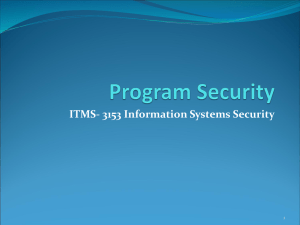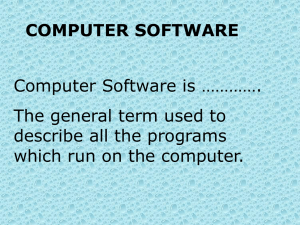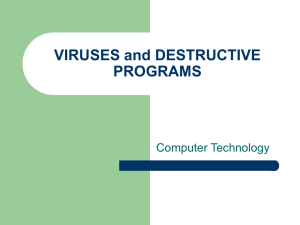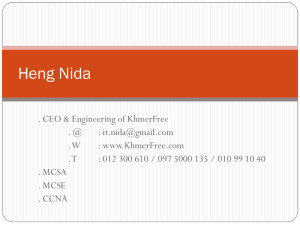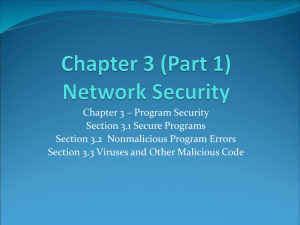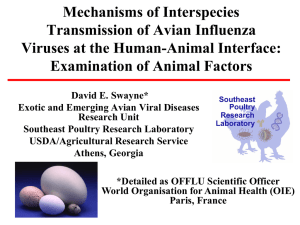Information Security Virus Propagation and Countermeasures: Is
advertisement
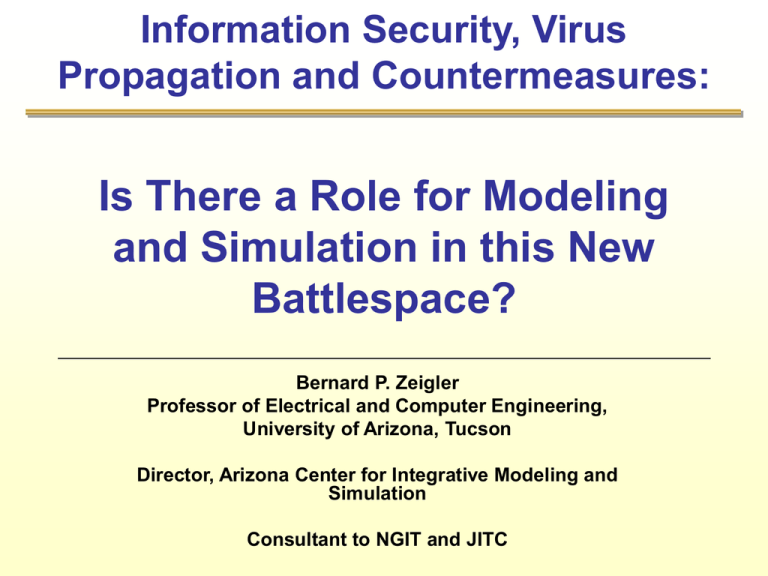
Information Security, Virus Propagation and Countermeasures: Is There a Role for Modeling and Simulation in this New Battlespace? Bernard P. Zeigler Professor of Electrical and Computer Engineering, University of Arizona, Tucson Director, Arizona Center for Integrative Modeling and Simulation Consultant to NGIT and JITC Computer Viruses – how bad is the problem? Fact: • The “I Love You” virus spread twice as fast as Melissa in its first ten hours • affected 70% of US companies • cost between $100 million and $1billion Conclusion: • computer viruses can do great harm to our economic and military infrastructures • need countermeasures and conversely, could be a way to attack an adversary Information Security, Virus Propagation and Countermeasures • A New Battlespace – information warfare • Modeling and simulation has proven its worth in the conventional battlespace • Is there a Role for Modeling and Simulation in the new battlespace? • How do we start thinking about this issue? M&S in the New Battlespace Computer modeling and simulation has been used in the conventional battlespace for: – – – – – understanding combat in the battle field weapons and systems design test and evaluation training many other uses How can we use M&S for modeling the new “battlefield” ? – how do viruses spread? – how to detect them? – how to neutralize them? Computer vs Natural Viruses – Are computer viruses like bio viruses? – How far does this common analogy stretch? – Does a computer get “sick” like a person? – Did the “love” virus infect computers and spread like Asian flu infects a population? Recent Case In Point: MyDoom Incident Report from ECE Network Administrator: • There is a fast moving virus called MyDoom going around. • Like many viruses this one will pick an e-mail address from the infected system and use it in the From: field of the virus infected message it sends out. • If your e-mail address is found on an infected system you will likely get a message from the mail server that your mail wasn't delivered. • This would indicate that someone you have an association with has the virus. • Sophos now has the signature to catch this virus and we will be pushing out the updates tonight and tomorrow. • There are likely to be a few infected systems in ECE and we will be conducting network scans tomorrow. • The virus comes as an attachment; you will probably have a significant number of these messages by tomorrow. • Just delete them and you are safe – needs to be opened to propagate Mode of Viral Transmission mail server infected computer from a to x from b to x user opens attachment from c to x c infected infected computer infected b computer computer a address book Antiviral countermeasures: • spread word to recognize and not to open attachment • add signature to anti-viral software • scan LANs and disinfect • turn systems off and reboot Spread of Infection Through Internet Topology of spread – neigbors are addresses in client’s addressbook Detecting Presence of Virus Normal Email Behavior Normal email behavior Professor Salim Hariri is developing capability to detect and neutralize viruses using agent-based software technology over the Internet number of invocations 1.2 1 0.8 0.6 0.4 0.2 0 -0.2 0 500 1000 1500 2000 Abnormal email behavior Abnormal Email Behavior Time (1.0s) 1 0.8 0.6 0.4 0.2 0 -0.2 0 20 40 60 80 100 120 140 Node VI (Under Attack) Node VI (No Attackl) Elevated Activity Level 160 Number of Invocations “termperature” 1.2 16 14 12 10 8 6 4 2 0 -2 0 500 1000 Time (1.0s) 1500 2000 Network Architectures of the Future, e.g. GigBE will allow built-in virus detection and eradication control plane data plane sentinel source (orange) and sink (green) packet time marker wave spreading virus restoration of infected cells spreading anti-virus slowing up of marker wave trigger countermeasure Viral and Antiviral Behavior normal revert antiviral infect ping ping anti revert anti infected packet wave behavior infect anti-viral propagation infect ping infection spread cell type/signal ping infect anti normal normal infected anti-virus infected no effect no effect anti-virus anti-virus no effect no effect no effect Sentinel Based Viral Detection sentinel source sink ping anti periodically generate packets\ flood detect travel time exceeds threshold Virus Propagation Model Demonstration Virus Propagation and Countermeasures Design: A New Paradigm • Develop models for information network protection applicable to new high speed infrastructure networks such as DoD’s GIGBE. Currently, there are few theories and models of virus propagation in large scale networks and design of effective counter-measures – a notable exception: Prof. Hariri and DARPA • A framework for virus and anti-virus propagation and interaction has been developed in the Discrete Event Systems Specification (DEVS) formalism and implemented in the DEVSJAVA modeling and simulation environment. A notional design for detecting virus propagation and launching countermeasures has been implemented. • Continue with the development of the framework, research feasible mechanisms for implementation in network hardware and software and test and evaluate them through more refined simulation. Summary • Interesting analogies and dis-analogies between natural and artificial virus propagation • Need formal simulation-based methodology to characterize viral behaviors and countermeasures • Current popular network simulators are too unwieldy to support this research and development • The new paradigm discussed here can! More Information on M&S www.acims.arizona.edu

